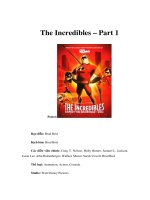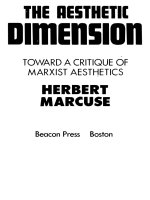The Transcendental Aesthetic (1): A Priori Intuitions potx
Bạn đang xem bản rút gọn của tài liệu. Xem và tải ngay bản đầy đủ của tài liệu tại đây (124.42 KB, 10 trang )
1/10
© Gary Banham & Manchester Metropolitan University, 2009
Kant, Level III, Lecture 3: The Transcendental Aesthetic 1,
Department of Politics and Philosophy, Manchester Metropolitan University.
The Transcendental Aesthetic (1): A Priori Intuitions
The first major section of the Critique is the Transcendental
Aesthetic. In this section Kant treats the question of what elements of
sensibility are a priori. In addressing this he opens by referring to
something called “intuition” (Anschauung). Two criteria are referred to that
mark something as an “intuition”. Firstly, it involves “immediate”
awareness (which reminds us of Descartes’ use of “intuition”) and the other
that it implies singularity (i.e. there is here a form of particularity that is not
subsumable under a universal). The relationship between these two criteria
is much disputed amongst writers on Kant as most think that one of them
must have priority over the other with the dispute concerning which it is that
has that priority. In any event, Kant first refers in the Critique to
“immediacy” mentioning it in the first line of the Aesthetic.
Apart from this point is also clear that for all finite cognizers
(including humans) intuition is something sensible. When the effect of an
object on the senses produces sensation then we have an empirical intuition.
This a posteriori element of intuition is also termed by Kant the matter of
intuition. By contrast, the form of intuition is what must apply to anything
that is sensational but which will not itself be sensational. This form of
intuition is the a priori element of sensibility. In order to uncover this a
priori form we need to establish what belongs to all sensation without being
2/10
© Gary Banham & Manchester Metropolitan University, 2009
Kant, Level III, Lecture 3: The Transcendental Aesthetic 1,
Department of Politics and Philosophy, Manchester Metropolitan University.
derived from it. This leads us to the view that there are two pure forms of
sense: space and time.
Having reached this point Kant goes on to give arguments for why
we should take space and time to have the status he is claiming for them.
Prior to giving his arguments for the view he is committed to he first refers
to the dispute between the Leibnizians and Newtonians concerning the
status of space and time (A23/B37-8). Kant’s subsequently will make two
separate claims about the status of space and time that must not be confused
with each other. The first claim is that space and time are a priori intuitions
and the arguments for this claim will be considered this week. A second
claim will give the first clue to his general doctrines of transcendental
idealism and empirical realism and we will turn to those claims next week.
But the arguments for space and time being a priori intuitions are presented
separately from those concerning transcendental idealism and empirical
realism and the point of the specific arguments needs to be clearly
established.
The arguments that are given for thinking of space as an a priori
intuition are substantially the same as those for thinking of time in this way
and traditionally only one of these sets of arguments tends to be considered.
I will follow this rule and only look at the arguments concerning space.
They are distinguished in the second edition in terms of metaphysical and
transcendental expositions. The metaphysical expositions concern the
3/10
© Gary Banham & Manchester Metropolitan University, 2009
Kant, Level III, Lecture 3: The Transcendental Aesthetic 1,
Department of Politics and Philosophy, Manchester Metropolitan University.
specific reasons for claiming that space is both a priori and intuitive whilst
the transcendental exposition suggests that it is only by considering space in
this way that we can justify some other form of knowledge-claim.
Space is presented as the form of outer sense (time the form of inner
sense). Five distinct arguments are given for thinking of space in the way
Kant suggests we should, some of which concern reasons for thinking it as a
priori, others for thinking of it as an intuition. The five arguments concern
externality, the conditions of representation, the uniqueness and unity of
space, the notion of space as an “infinite given magnitude” and the
transcendental exposition concerns geometry (motion in the case of time).
The externality argument is given first (A23/B38). Here Kant claims
that space is not a concept derived from experience since any means of
relating sensations to anything beyond me and as different from each other
in terms of occurring at different points presupposes the notion of space.
This is an argument for thinking of space as a priori in terms of being a
necessary condition of representing relations.
There is a general objection to this argument to the effect that it
states a tautology. Peter Strawson, for example, states this claiming that all
the argument says is that we could not become aware of objects as spatially
related unless we had the capacity to do so. A slightly different objection to
the argument is that it does not prove that space is a priori, just that it is
prior to certain other parts of knowledge. (Graham Bird mentions this
4/10
© Gary Banham & Manchester Metropolitan University, 2009
Kant, Level III, Lecture 3: The Transcendental Aesthetic 1,
Department of Politics and Philosophy, Manchester Metropolitan University.
point.) In response to Strawson’s objection two separate points have been
made. Firstly, it is possible to argue that what Kant is focusing on is the
difference between self and objects and that this difference is brought out as
requiring space so that space is necessary for it. (This would be based on the
point that sensations be referred to something beyond me.) However, that
the sensation is something in some sense distinct from what has the
sensation does not show that we require the view that space really exists so
if this is Kant’s argument then it is not a good one.
A second type of reply would be that what Kant has shown is that to
have a conception of external relations (the sensation being different from
who has it) we must first have a sense of external order (the sensation being
different in different places) and this latter requires something that does not
come from the sensation itself. This would be to the effect that to coherently
relate to sensations as having patterns and distinctions requires that they be
located in space. This fits the text of the argument much better and appears
to be a sound argument.
In responding to Bird’s claim that the argument only establishes
priority of order over relations and is not sufficient to show that the order
that is given by space to sensations is something a priori it is true that we
have not shown in this argument that space is universally needed for the
experience of sensation to, in any given instance, be coherent. But what the
argument would show is that it is necessary for sensation to be continuously
5/10
© Gary Banham & Manchester Metropolitan University, 2009
Kant, Level III, Lecture 3: The Transcendental Aesthetic 1,
Department of Politics and Philosophy, Manchester Metropolitan University.
related to in a coherent manner (so only in one of the senses of a priori
would space have been shown to be a priori).
The second argument, which concerns representation, is likewise
one that appeals directly to conditions of representation. (A24/B38-9) Here
Kant argues that we can’t represent the absence of space though we can
think of space as empty of objects. The conclusion of this is that space is a
condition of the possibility of objects appearing and not something that is
dependent on the objects. A couple of objections have been made against
this argument. One would be that the claim is only psychological and
contingent and shows nothing that would make space a priori. Another
objection would be to the claim that we can really think of space as empty
of objects, that, in some sense, to really think space we need to relate it to
something that is, in some sense, in space.
The claim that the argument has, if successful, only established a
psychological and contingent result, is a less serious objection than it first
appears. Should it be the case that there is a difference between being able
to represent space separately from objects and not being able to do the
reverse then this would establish a distinction that would certainly suggest a
necessary dependence of objects on space. This dependence would not be
psychological in the empirical sense since it would apply to any attempt by
any finite cognizer to relate space and objects, not just some contingent
peculiarity.
6/10
© Gary Banham & Manchester Metropolitan University, 2009
Kant, Level III, Lecture 3: The Transcendental Aesthetic 1,
Department of Politics and Philosophy, Manchester Metropolitan University.
The objection that really matters then is whether Kant is right to
make the distinction that he does in the argument or, put differently,
concerns what the distinction he is arguing for really is. So Kemp Smith, for
example, argues that the problem with this second argument is that Kant
does not consider alternative accounts of the reason for the relationship
between space and objects that he suggests holds. Kemp Smith gives as an
alternative Hume’s view that there could be an association formed here that
becomes fixed. What Kemp Smith’s objection fails to note however is that
such a claim would not be sufficient to show that space is necessary for
objects to be represented as an association is not a necessity. Geometry can
be brought in to support Kant’s claim that space can be conceived separately
from objects as with geometry we do not need to appeal to characteristics of
physical things at all and yet we do conceive of space. So it is possible to
think space in such a way that there are no objects in it and no sensations
placed in it and this would show that space was prior to objects but if we
add that no objects can be represented separately from space then this would
show space was necessary for objects and hence a priori in one sense.
The first two arguments, if successful, show space to be a priori in
the sense of necessary though the second would also have as its
consequence that space is universally required for the experience of objects.
The third argument (fourth in the first edition) aims to show that space is not
a concept but a pure intuition. (A24-5/B39) Here Kant states that space is
7/10
© Gary Banham & Manchester Metropolitan University, 2009
Kant, Level III, Lecture 3: The Transcendental Aesthetic 1,
Department of Politics and Philosophy, Manchester Metropolitan University.
represented as a unique unity. What makes it so is that parts of space cannot
precede the sense of the whole of space. The parts can only be understood
as in the whole with the sense of distinct spaces rather emerging as
derivative of the whole from cutting it up into parts. This argument concerns
mereology (theory of parts and wholes). Some wholes emerge from parts
and are derivative of them whilst in other cases the sense of the part-whole
relationship requires that the whole first be given and the parts then follow
from it. In the latter case, we have, Kant is arguing, a singular whilst in the
former case there emerges a universal by abstraction from particulars.
To see the point of Kant’s distinction here we can contrast the way
concepts work with how he is claiming intuitions function. With a concept
any instance of it can capture the sense of the whole (so for example “Fido”
is sufficient for the concept of “dog” even though “dog” is more general
than “Fido”). By contrast, a part of space is only an area and does not
capture the sense of space as such. Rather, it is because of the sense of space
as a unique whole that the specific region makes sense. To put this
differently, the universal features that we have in mind in the concept “dog”
are exemplified in each dog (the differences between them notwithstanding)
so that the universal just summarizes them whilst space is continuously
given as a unique unity and the sense of the parts is only through the general
whole. Whilst the universal concept can thus arise from the particulars, the
specific parts of space presuppose the whole.
8/10
© Gary Banham & Manchester Metropolitan University, 2009
Kant, Level III, Lecture 3: The Transcendental Aesthetic 1,
Department of Politics and Philosophy, Manchester Metropolitan University.
The objections to this argument typically touch on only part of the
claim it makes: namely, that space is a unity. Some have claimed that spaces
could exist separately from each other (Anthony Quinton). Others have
suggested that the argument here does not exclude alternative views of
space to that it is an intuition, that there could be alternative explanations
given. However, if the view that there could be separate spaces is meant to
be a conceptual possibility there are two problems with it. Firstly, it requires
a gap between the spaces and it is difficult to see how that can be
characterized except in terms of a further space. Secondly, such a
conceptual possibility, even if granted, does not show that it would be
possible to experience such separation. In relation to alternative views, what
is denied here is that space is a notion that could have arisen from
particulars and this denial is the substance of the claim that space is an
intuition as, by the criteria of singularity, it is only of intuitions that this
could be true.
The fourth argument (fifth in first edition) (A25/B39-40) concerns
the representation of space as an infinite given magnitude. Here Kant
sharpens the contrast between concepts and intuitions. With concepts there
are a number of possible different representations which are contained
under the general heading that they describe. But this class-inclusion
relation is quite different from having the sub-representations included
within the general heading as is the case with space. Due to having the latter
9/10
© Gary Banham & Manchester Metropolitan University, 2009
Kant, Level III, Lecture 3: The Transcendental Aesthetic 1,
Department of Politics and Philosophy, Manchester Metropolitan University.
relationship to its sub-representations space is an intuition. The reason why
all the elements of space are within it rather than under it is due to the fact
that all the parts of space have to coexist together as shown in the previous
argument.
The second two arguments, if successful, show that space is an
intuition and carry with them the sense that space is, in so being, a unique
singular (a kind of universal particular). This added to the points showing it
to be a priori lead us to the conclusion that it is an a priori intuition. Kant
then proceeds to give a transcendental exposition, which concerns
geometry. It is only carefully distinguished from the metaphysical
expositions in the second edition where it is given at B40-41 (corresponding
to A24). In the first edition Kant presented this argument simply as that the
certain character of geometrical propositions was made possible by the a
priori necessity of space and that if space was something we arrived at by a
posteriori induction then our view of it would be merely perceptive and
contingent.
In the second edition this argument is expanded and here Kant points
to the view that geometry is a body of synthetic a priori truths. The
condition of possibility of this must be that space is an intuition as from
concepts alone we could never make discoveries (everything would be
analytic). Further, the statements of geometry must be a priori, that is, be
10/10
© Gary Banham & Manchester Metropolitan University, 2009
Kant, Level III, Lecture 3: The Transcendental Aesthetic 1,
Department of Politics and Philosophy, Manchester Metropolitan University.
comprehended prior to any empirical intuitions, just because its statements
are certain which they would not be if derived from empirical intuitions.
A final argument specifically concerning the status of space as an a
priori intuition is given in the Prolegomena but not repeated in the Critique.
This is the argument from incongruent counterparts. The example given is
that of right and left hands. They are counterparts to each other and,
considered purely conceptually, appear to be the same. Yet, as is easy to see,
they are incongruent. If you place a left hand in front of a mirror the image
reflected of it will place it on your right side. The difference between the
hand and its reflection shows that right and left are incongruent as you
could not replace one with the other. But the difference between them
cannot be in anything conceptual so this shows that fundamentally space is
an intuition.









